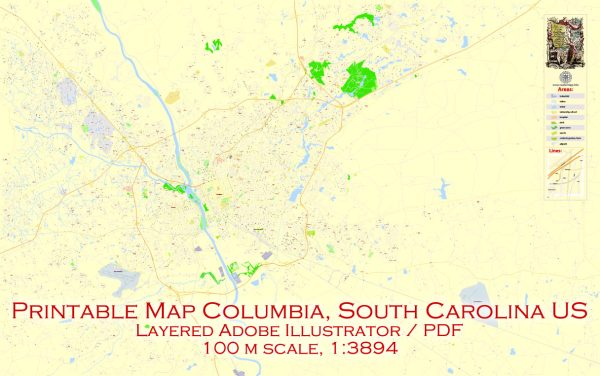Columbia, the capital city of South Carolina, has a rich economic history that spans centuries. The city’s economic development has been shaped by various factors, including agriculture, transportation, industry, and the presence of government institutions.
Vectormap.Net provide you with the most accurate and up-to-date vector maps in Adobe Illustrator, PDF and other formats, designed for editing and printing. Please read the vector map descriptions carefully.
Here is a detailed overview of the economic history of Columbia, South Carolina:
- Colonial Era (1600s-1770s): The region around Columbia was inhabited by Native American tribes, including the Congaree people, before European settlers arrived. In the late 1600s, English and French settlers established small agricultural communities. The economy was primarily agrarian, with crops such as rice, indigo, and tobacco playing significant roles.
- Antebellum Period (1780s-1860s): Columbia was chosen as the state capital in 1786 due to its central location in the state. The city’s economy continued to rely on agriculture, with cotton becoming a major cash crop. The construction of the Columbia Canal in the early 19th century facilitated transportation and provided power for early industrial development.
- Civil War and Reconstruction (1860s-1870s): The Civil War had a profound impact on Columbia, as the city was burned during General Sherman’s March to the Sea in 1865. Reconstruction brought challenges, but the city gradually recovered. Agriculture remained crucial, but there was also a growing emphasis on manufacturing and trade.
- Late 19th to Early 20th Century: The late 19th century saw the expansion of the textile industry in Columbia. Cotton mills became prominent, and the city’s economy diversified. Transportation infrastructure, including railroads, further facilitated economic growth. Columbia continued to benefit from its role as the state capital, with the presence of government institutions contributing to the local economy.
- Mid-20th Century: Columbia’s economy continued to evolve with the growth of education and healthcare sectors. The University of South Carolina, founded in 1801, played a significant role in shaping the city’s educational landscape. The healthcare industry, anchored by institutions like Palmetto Health, became an essential economic driver.
- Late 20th Century to Present: In the latter half of the 20th century, Columbia continued to diversify its economy. The military presence, including Fort Jackson, has been an important economic factor. Additionally, the city has seen growth in sectors like finance, technology, and services. The revitalization of downtown Columbia has attracted investment and contributed to the city’s economic vibrancy.
- Recent Developments: As of my last knowledge update in January 2022, Columbia has experienced ongoing urban development, infrastructure improvements, and a focus on promoting entrepreneurship and innovation. The city’s economy remains diverse, with healthcare, education, government, and various industries contributing to its overall stability.
It’s important to note that economic histories are dynamic, and developments may have occurred since my last update. For the most current information, it’s advisable to consult recent local sources and economic reports.


 Author: Kirill Shrayber, Ph.D.
Author: Kirill Shrayber, Ph.D.